A Painting of the 'Starchild'
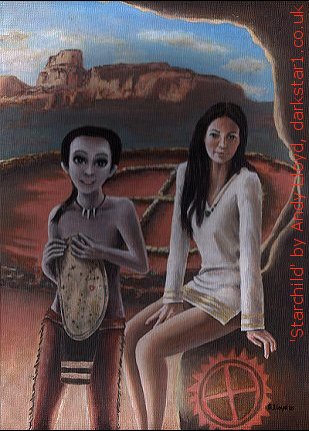
by Andy Lloyd
A Painting of the 'Starchild'

by Andy Lloyd
The Starchild project is an on-going research programme whose goal is to identify the origins of a 900 year old relic which was found in a cave in Mexico some years ago. The relic is a skull of a child whose deformities are so severe that serious questions have been raised as to whether the child can truly be said to be completely human! The child's remains were accompanied by those of a woman, assumed to be his mother. To get to the truth of the matter, privately funded scientific research in the form of DNA testing has been carried out, with the hope of more conclusive tests due some time in the future.
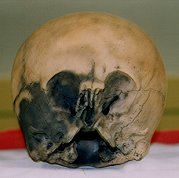
The 'guardian' of the skull is Lloyd Pye, an American researcher who heads a team trying to galvanise support to further the science of the skull's origins. Lloyd Pye has a keen interest in anthropology and has lectured at many venues about this so-called 'Starchild Skull'. One of those events was organised by my colleagues and I here in Gloucester, subsequently featuring in the local press and on the television news at the time. Along with many in the 'Ufology' community I have followed the ups and downs experienced by the Starchild researchers with more than just a casual interest. I have always found the story of the origin of this relic to be a fascinating one, for reasons that will soon become apparent.
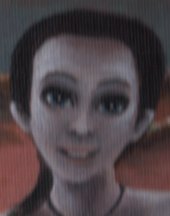
My painting of 'Starchild' encapsulates the original background story and attempts to put a face to a name, so to speak. It is necessarily a rather speculative piece of art, and I include a few notes here to explain it. The painting was originally intended to simply provide an image of the child as he would have looked when alive. I have worked on the assumption that the child was an Indian living in the desert of north Mexico and so I have clothed him in leather trousers and a North American Indian necklace. He also has long, dark hair in keeping with many North American tribal traditions. His facial features accentuate his eyes and odd-shaped skull, incorporating an 'alien' look. I have consciously tried to avoid him looking grotesque, but have attempted to portray a beautiful, but very weird looking child.
The colour of his skin is controversial. In order to portray the possibility that this so-called 'Starchild' is an alien hybrid I decided to paint his skin greyish, with some more normal skin tones included to humanise his alien appearance. Bear in mind that it is not known for sure what the true origins of the Starchild are, but the very name that has been coined to describe him provides us with a 'modern myth' of alien intervention on our planet; one that has captured the imagination of many. The other bones that were originally discovered with the skull showed many deformities, which I have chosen to interpret as alien. Those bones are now lost and were never studied in depth, so we simply don't know if this is the case.
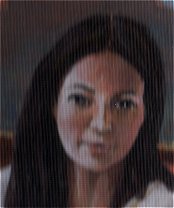
The mother is the centre-point of the painting for me. I have given her Mexican features, although she has ended up somewhat Caucasian in skin colour (she has some European DNA apparently). I have dressed her in fairly fine clothes for the period, with a jade necklace to accentuate her Meso-American background. She is a beautiful figure and is meant to be: It strikes me that the finding of a mother and child in a cave has some fairly deep mythological characteristics. The child is said to be from the stars, implying a miraculous conception of sorts. So the mother becomes a Madonna, the boy a mythological child from on high. There are many Pagan examples of this kind of thing, known generally as the myth of the 'dying and rising' god. A prime example of this myth is the Christian Nativity which was essentially lifted from previous traditions.
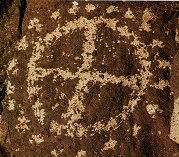
So our Starchild Madonna of the Rocks is dressed in white, perhaps implying virginity. She looks directly towards us confidently, her hands communicating with us. Her right hand rests on her leg, hinting at her sexual nature. Her left hand points to a cave-painting, or petroglyph, of a fiery wheel containing within it a cross. This red symbol is seen repeatedly painted by Barbareno Chumash artists about 1000 years ago, for example in caves high in the Santa Ynez mountains of Southern California. It is thought that the circled cross symbol is connected with the Meso-American god Quetzalcoatl and the Hopi Sky God.
An interlinking of several North and Meso-American cultures has been implied by this symbol (and I have freely interlaced these essentially interwoven cultures here, including location). Such religious imagery is in keeping, then, with my argument about a 'dying and rising' god parallel. It also implies the intervention of a Sky God, or gods. And it may even link the myth to the 'Planet of the Crossing', Nibiru, which has been associated with early Winged Discs and Winged Crosses.

The background of my painting is that of the Medicine Wheel overlooking Long Canyon in Sedona, Arizona. This is a sacred site par excellence, reportedly awash with strong earth energies. The circled cross of the Medicine Wheel itself accentuates that of the cave pictograph, and again provides a link to the sky with its archeo-astronomical connotations.
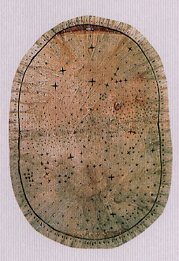
The third item in this symbolic trilogy is the embroidered buckskin held closely to the chest by the Starchild, who seems to draw comfort from it . It is a Pawnee star chart and is described here by Gene S. Stuart:
"(It)...depicts heavenly bodies vital to the tribe's mythology of creation'. Scholars believe the chart was part of a sacred bundle - a sort of portable altar containing various relics and used in planting and hunting ceremonies. But its exact purpose and even its age remain obscure, its lore lost to time."
The Pawnee lived in present day Nebraska and are thought to have been influenced by the cultures of Southwest America and Mesoamerica, again permitting a crucial link within my painting. Note the red crescent and star towards the centre; is this Nibiru near the V-shaped Taurus constellation above it?
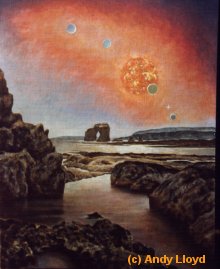
There are also a few symbols that ended up in the painting quite by accident. The mountains behind the Long Canyon look like a Sphinx, which is a bit odd but quite apt; the Sphinx faces due East as a equinoctial marker. Also, the Medicine Wheel rather neatly binds the child and mother together, with the cross fragment shown looking like a chromosome. And finally, and this is a bit Dali-esque, the mother of the Starchild is sat upon a rock jutting out from the cave mouth. The shape of this rock, combined with the one slightly behind it, aren't hugely dissimilar to a pair of breasts! Which I suppose unconsciously reinforces the underlying sexuality of the Madonna figure in the painting.
This is an unusual painting for me because I tend to work on realistic artwork based upon photographs. An exception was a painting I did in 2001 of Nibiru (right) which was intended to be the front cover of 'Winged Disc'.
Finally, I should may it clear that my 'Starchild' painting is an independent and unofficial interpretation and does not necessarily reflect the opinions held by Lloyd Pye or associates within the Starchild Project at Cognoscence, London.
The 'Starchild' painting is 10" x 14" painted in acrylic on canvas board, 2005
Written by Andy Lloyd, 12th January 2005
author of 'The Dark Star' (2005), 'Ezekiel One' (2009), 'The Followers of Horus' (2010) and 'Darker Stars' (2019)
References
Lloyd Pye "The Starchild Skull: Genetic Enigma or...Human-Alien Hybrid", Bell Lap Books, 2007
If you live in the UK, you can obtain your copy through Amazon.co.uk here:
Andy Lloyd "Lloyd Pye at Gloucester" 2003-4
Courtney Milne "Sacred Places in North America: A Journey Into the Medicine Wheel" Stewart, Tabori & Chang 1994
![]() Sacred Places in North America
Sacred Places in North America
Gene Stuart "America's Ancient Cities" National Geographic Society 1988
The original Pawnee Star Chart is in the Field Museum of Natural History.